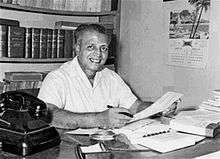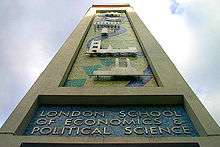N. M. Perera
| The Honourable N. M. Perera MP, DSc | |
|---|---|
 | |
| Leader of the Opposition | |
|
In office 19 April 1956 – 5 December 1959 | |
| Prime Minister | S. W. R. D. Bandaranaike |
| Preceded by | S. W. R. D. Bandaranaike |
| Succeeded by | C. P. de Silva |
|
In office 14 October 1947 – 8 April 1952 | |
| Prime Minister |
D. S. Senanayake Dudley Senanayake |
| Succeeded by | S. W. R. D. Bandaranaike |
| Minister of Finance | |
|
In office 10 May 1970 – 2 September 1975 | |
| Prime Minister | Sirimavo Bandaranaike |
| Preceded by | U. B. Wanninayake |
| Succeeded by | Felix Dias Bandaranaike |
|
In office 11 June 1964 – 17 December 1964 | |
| Prime Minister | Sirimavo Bandaranaike |
| Preceded by | T. B. Ilangaratne |
| Personal details | |
| Born |
6 June 1905 Sri Lanka |
| Died | 14 August 1979 (aged 74) |
| Nationality | Sri Lankan |
| Political party | Lanka Sama Samaja Party |
| Spouse(s) | Selina Perera[1] |
| Alma mater | St. Joseph's School , Cathedral Boys School, S. Thomas' College, Mutwal, Ananda College, University College, Colombo, London School of Economics |
| Occupation | Economist |
Nanayakkarapathirage Martin Perera, better known as Dr. N. M. Perera,(Sinhala ඇන්.ඇම්.පෙරේරා [en em pe reaira]; 6 June 1905 – 14 August 1979) was one of the leaders of the Sri Lankan Trotskyist Lanka Sama Samaja Party (LSSP). He was the first Trotskyist to become a cabinet minister.
Early life and education

NM Perera was born to Nanayakkarapathirage Abraham Perera who was a rent collector at No 36 St Joseph 's Street, in Grandpass, Colombo.His Mother Johana perera and He was Fifth of nine members of family of five boys and four girls.[2]
Perera started his schooling in the vernacular section of St. Joseph's School, Grandpass and was later was admitted to the English section. From there he was sent for one year to a Branch School of S. Thomas' College, Mutwal,[3][4][5] then known as Cathedral Boys School, Mutwal. In 1919 he entered St Thomas' prep, but left in 1922 and joined Ananda College. At Ananda he played cricket for the school.
He obtained a bachelor's degree from University of London External System at the University College, Colombo during 1922–27 and then left for the UK to join the London School of Economics and University of London, 1927–33.[6] There he was a student of the legendary Professor Harold Laski, being awarded a PhD for his thesis on the Constitution of the German Weimar Republic. A further comparative study, of the Constitutions of the UK, United States, France and Germany, won him a DSc from the University of London. At the time Perera was the only person in Sri Lanka to hold the degree of Doctor of Science.
Political life
The work done by Perera (as a member of the Suriya-Mal Movement) in the Kegalle district during the Malaria Epidemic of 1934 and during the subsequent floods gained for him the support of the poor and caste-oppressed people of the area, who called him Parippu Mahathmaya after the dhal (or parippu) he distributed as relief supplies.
In 1935 Perera was one of the founder members of the LSSP. In 1936 he contested the Ruwanwella constituency, which at the time was the Thun Korale areas of Yatiyantota, Ruwanwella and Dereniyagala and parts of the present Galigamuwa electoral division, from the LSSP. His opponent was Molamure Kumarihamy of the Meedeniya Walauwa, the feudal manor which had tremendous power over the poor people of the Sabaragamuwa area at the time. He was to hold this seat, or its Yatiyantota portion on division, continuously until 1977.
After his election, he and Philip Gunawardena (the other LSSP member of the State Council), acting as people's tribunes used the State Council as a platform to carry forward the party's struggle to gain full independence for the country from the British. At the time only people like N.M. Perera and the LSSP stood for complete independence for Sri Lanka: the leaders of the Ceylon National Congress were only concerned with obtaining concessions from the British.
He was imprisoned in 1940 during World War II, but succeeded in escaping on 5 April 1942. He secretly went to India and worked with the Bolshevik-Leninist Party of India, Ceylon and Burma (BLPI) in that country's independence struggle. But According to Encyclopedia of Marxism 1936–40, he was the LSSP delegate to Indian National Congress session, 1937. Formed Ratmalana Railway Workers' Union, 1937, and All-Ceylon Estate Workers' Union, 1939. Led militant strike at Mooloya Plantation, January 1940. Arrested June 1940, incarcerated at Wellikade Jail and Bogambara Prison. Escaped to Bombay, July 1942. Arrested in Bombay, July 1943. Jailed at Badulla, 1943–45.[6]
After the war, when the LSSP split, Perera was the leader of the faction that retained the party name. After the 1947 general election, he was elected Leader of the Opposition.
On reunification with the Bolshevik Samasamaja Party (BSSP), he remained with the LSSP when the Viplavakari Lanka Sama Samaja Party (VLSSP) split off under Philip Gunawardena.
Perera was elected Mayor of Colombo in 1954, the only non-United National Party-politician to take that office after 1945. He was Mayor for two years. In 1956 he was elected Leader of the Opposition again, a post he held until 1960.
When LSSP was divided over possible government participation in early 1960s, Perera was the principal leader of the wing that wanted to enter into government with the Sri Lanka Freedom Party, which led to LSSP's expulsion from the Fourth International in 1964.
He was Minister of Finance in the short lived Coalition government of 1964 – 1965 and in the United Front government of 1970 – 1975.
In the general election of 1977, he lost his parliamentary seat for the first time, (except for the period he was imprisoned during the Second World War) having won every single election for the Ruanwella constituency or for its successor, Yatiyantota.
His funeral in 1979 was one of the largest ever seen in Sri Lanka.
Trade union activities
Perera was the president of the All Ceylon United Motor Workers' Union, and the United Corporations and Mercantile Union the Ceylon Federation of Labour (CFL). He was appointed their chief negotiator by the striking workers during the 1946 general strike.
Other activities
An avid cricket fan, like many Commonwealth Trotskyists, he became Chairman of the Board of Control of Cricket in Sri Lanka, and worked hard to obtain test status for Sri Lanka.[7]
Further reading
- Dr. N.M. Perera's Policies and Achievements by Prof. B. Hewavitharana[8]
- Parliamentary Democracy (1931) By N.M. Perera,
- The Case for Free Education (1944) By N.M. Perera,
- External Economic Assistance (1964)By N.M. Perera,
- The Economy of Ceylon: Trends and Prospects (1971)By N.M. Perera,
- Critical Analysis of the New Constitution of the Sri Lanka Government (1979)By N.M. Perera,[6]
See also
References
- ↑ "Selina Perera – The relentless revolutionary". The Island (Sri Lanka). 12 April 2009. Retrieved 5 February 2016.
- ↑ "Dr. NM Perera: a politician ahead of his times" (PDF). pdfs.island.lk. 2009. Retrieved 13 August 2009.
- ↑ Dr. N.M. Perera 1905 – 1979 : An honest and upright politician
- ↑ Dr. N. M. Perera: A true visionary
- ↑ Doughty fighter and man of principles
- 1 2 3 "MIA: Encyclopedia of Marxism: Glossary of People". Encyclopedia of Marxism:.
- ↑ "Colossus among political leaders". dailynews. 2009. Retrieved 14 August 2009.
- ↑ "Dr. N.M. Perera – Parliamentarian – par excellence". Daily News. 10 January 2007.
External links
- Dr N.M. Perera a colossus among leaders
- 'Why Implant a New System of Government?' Part I
- 'Why Implant a New System of Government?' Part 2
- Official Website of Lanka Sama Samaja Party
- Official Website of DR.N.M. PERERA TRUST
- Dr. N.M. Perera 1905 – 1979 :An honest and upright politician
